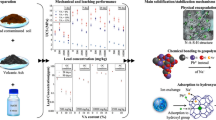Abstract
Sepiolite and attapulgite were identified by X-ray diffraction, elemental, and thermal analyses in the calcareous zone of a soil formed on a relict basin-fill plain in Dona Ana County, New Mexico. Sepiolite occurs in the lower part of the zone of calcium carbonate accumulation; attapulgite occurs above, in, and below the sepiolite zone.
The sepiolite was observed as whitish aggregates remaining after the carbonate was dissolved with sodium acetate buffer (pH 5). Extended treatment with this buffer dissolved a significant amount of the sepiolite but did not appear to dissolve much attapulgite. Sepiolite was concentrated for analysis without significant solution by separating the <100 mesh material from the crushed soil, treating it with pH 5 buffer for a short time and separating the carbonate-free clay. The sepiolite is relatively high in aluminum compared to most sepiolites.
The sequence of dominant clay mineral with depth in the profile is montmorillonite, attapulgite, sepiolite, attapulgite, montmorillonite. No sepiolite or attapulgite was found above the calcareous zone; a little attapulgite was found at the base of the profile, which was not totally free of carbonates. Thin sections showed sepiolite and attapulgite occurring as aggregates, as coatings on mineral grains and as small fibers. The distribution of these minerals in the profile and the arrangement of the small fibers in the calcrete suggest that these minerals crystallized during the period of caliche formation.
As will be seen (Table 5) the sepiolite is present mainly in the nodular calcareous zone; the attapulgite, mainly in the blocky calcareous zone and in the transition zone below the calcareous zone (C6).
Similar content being viewed by others
References
Bradley, W. F. (1940) The structural scheme of attapulgite, Am. Mineralogist 25, 405–10.
Braunbr, K., and Preisinger, A. (1956) Struktur und Entstehung des Sepioliths, Tschermaks Mineral. Petrogr. Mitt. 6, 120–40.
Brindley, G. W. (1959) X-ray and election diffraction data for sepiolite, Am. Mineralogist 44, 495–500.
Brown, G. (Editor) (1961) X-ray Identification and Crystal Structures of Clay Minerals, 2nd ed., Mineralogical Society, London.
Dunham, K. C. (1935) The Geology of the Organ Mountains, New Mexico School of Mines, Bull. 11.
Gilb, L. H. (1961) A classification of ca horizons in soils of a desert region, Dona Ana county, New Mexico, Soil Sci. Soc. Amer. Proc. 25, 52–61.
Gile, L. H., Peterson, F. F., and Grossman, R. B. (1965) The K horizon: a master soil horizon of carbonate accumulation. Soil Sci. 99, 74–82.
Grossman, R. B., and Millet, J. L. (1961) Carbonate removal from soils by a modification of the acetate buffer method, Soil Sci. Soc. Amer. Proc. 25, 325–6.
Jackson, M. L. (1956) Soil Chemical Analysis—Advanced Course, Published by Author, Madison, Wisconsin.
Mackenzie, R. C. (Editor) (1957) Differential Thermal Investigation of Clays, Mineralogical Society, London.
Millot, G. (1962) Geochemical aspects of weathering and sedimentation, Proc. Symp. Basic Sci. France U.S., New York, [1960], pp. 159–69.
Millot, G., Elouard, P., Lucas, J., and Slansky, M. (1960) A sedimentary and geochemical sequence of clay minerals, montmorillonite, attapulgite, sepiolite, Bull. Groupe Franc. Argiles 12, 77–82.
Mumpton, F. A., and Roy, R. (1958) New data on sepiolite and attapulgite, Clays and Clay Minerals, Nat. Acad. Sci.—Nat. Res. Council, Publ. 566, pp. 136–143.
Preisinger, A. (1959) X-ray study of the structure of sepiolite. Clays and Clay Minerals, 6th Conf. [1957], pp. 61–7, Pergamon Press, New York.
Rogers, L. E. R., Quirk, J. P., and Norrish, K. (1956) Occurrence of an aluminumsepiolite in a soil having unusual water relationships, J. Soil Sci. 7, 177–84.
Ruhe, R. V. (1964) Landscape morphology and alluvial deposits in southern New Mexico, Ann. Assoc. Am. Geographers 54, 147–59.
Vanden Heuvel, R. C. (1965) Elemental analysis by X-ray emission spectrography, Methods of Soil Analysis, Am. Soc. Agron. Monograph 9, Chapter 52.
Author information
Authors and Affiliations
Rights and permissions
About this article
Cite this article
Vanden Heuvel, R.C. The Occurrence of Sepiolite and Attapulgite in the Calcareous Zone of a Soil Near Las Cruces, New Mexico. Clays Clay Miner. 13, 193–207 (1964). https://doi.org/10.1346/CCMN.1964.0130120
Published:
Issue Date:
DOI: https://doi.org/10.1346/CCMN.1964.0130120




